This post may contain affiliate links.
Let’s take a bet.
Next time you see an RVer, ask them what the most challenging part of packing for a road trip is for them.
I bet I know the answer! Most will say it’s packing the food.
Meal planning for RV trips can get stressful for even the most seasoned RVers. But of course it’s not just limited to RVers! Healthy meal planning in general can be a big pain in the butt, RVer or not. Which is funny (in that not-funny sort of way), what with all the bazillions of healthed-up recipes out there and the endless supply of healthy meal prep advice available with just a quick Google search.
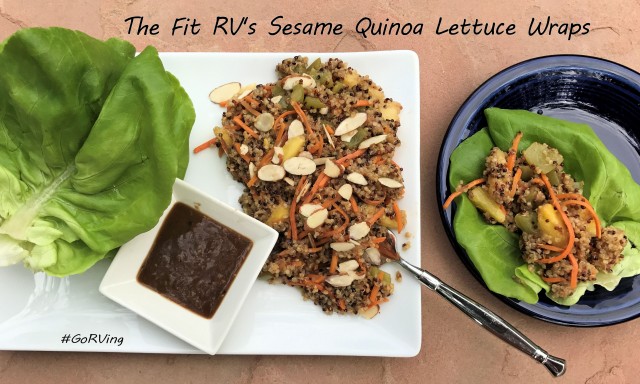
Here’s my whole theory on that.
We’re looking at it wrong.
Yup. I think we’ve become conditioned to see meal planning as a whole… like a card you pull out of a recipe box, and whatever its title is, well that there is dinner.
Us: “Ugh, what should I make for dinner this week…lasagna, soup, burritos, etouffée…blah”
Focusing on that end product, that’s where the system starts to break us down.
Us: “Okay fine, etouffée, better go find a very involved recipe so I can shop for all 500 ingredients and then spend all day in the kitchen…”
We’re good at making it complicated too.
Instead of looking at dinners (and lunches too) as a whole, try thinking about meals a little differently. You’re planning out the parts instead of the final product. A formula instead of a recipe, get it?
Like this:

This formula is how I build the majority of our lunches and dinners, whether we’re out in the RV or back home in the good old sticks and bricks. Well, technically, sticks and stucco is more accurate…
Think of it more like the way you get dressed in the morning. Maybe you start with your shirt drawer. You open it, pick whatever shirt floats your boat that day and THEN you start thinking about which pants will go with that shirt. Next you pick socks that complement the whole ensemble and don’t look too nerdy. So in the end, everything goes. We do this get-dressed thing each day without much fanfare. You build your outfits in layers, and THAT’S how to approach recipe-free healthy meal-planning too.
Here’s a dinner/lunch visual I made that might help you get what I mean:
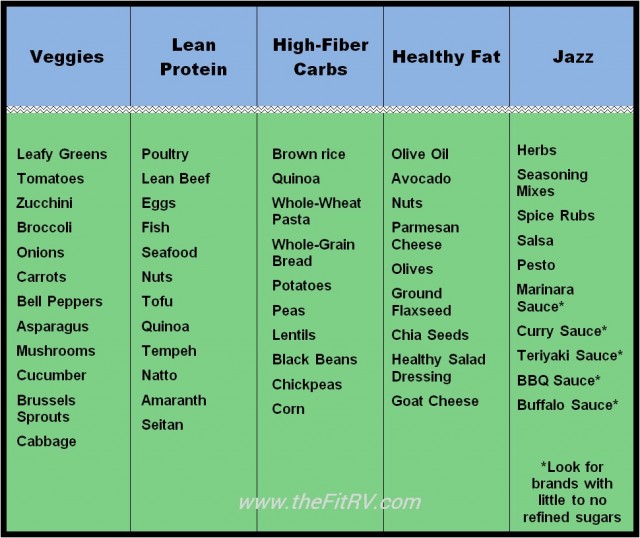
Here we’ve got the 5 categories in my formula, and a bunch of examples of foods we can choose from in those categories. And yes I know, there’s carry-over between categories, and I also understand not all the foods listed are foods you eat. Stay with me on the big picture here, which is this:
Our tendency to over-complicate meal planning and prepping can drag us down and make it something we dread. It doesn’t have to be that way, and can actually be quite simple.
Speaking of Simple:
Now, when I’m planning meals for RV trips, I’ve got a few more strategies I use besides just the formula.

Strategies For Healthy Meals in the RV:
First:
I figure out how many days until we’ll be back in civilization near a store. Ideally, I like to shop for 3 days’ worth of groceries, but that’s not always possible and sometimes I have to plan for more days before hitting a store. Whatever that number is though, I plan for ONLY those days and not one thing more.
Second:
I figure out veggies, fats, and sometimes even jazz that I can re-use over the course of those days so I’m keeping my shopping list to a minimum. If I’m only going to use shaved parmesan one day for one meal, and then I’m stuck hauling the rest of the container around the whole trip, why bother? So if I’m determined to have that meal with shaved parmesan, you can be sure parmesan will be popping up often over the course of those 3 days’ dinners and lunches.
Third:
I’m a huge fan of farmers’ markets. When we’re out on the road, I try to research local farm stands where I can stock up on local fare. I’ll go in with no plan and buy whatever excites me and then I plan my meals around whatever components I bought using the formula. For this Utah gal, there’s nothing like the experience of buying fresh seafood right off the pier and then grilling it up at our campsite on the ocean.
Here’s a Typical 3-Day Healthy Meal Plan in our RV:
Each of these meals was built using the formula instead of a recipe. Since it’s for the RV, I try to re-use items on my shopping list to keep it as simple as possible.
Day 1:
Lunch: Open-faced tuna (on one slice of whole grain bread) mixed with avocado and curry sauce on a slice of whole-grain with a fresh veggie salad and parmesan sprinkled over everything
Dinner: Grilled BBQ chicken, corn on the cob, with fresh salad and healthy dressing
Day 2:
Lunch: Open-faced seitan (on one slice of whole grain bread) with BBQ sauce and a fresh salad with a sprinkle of parmesan over everything
Dinner: Shrimp and veggie skewers, with quinoa tossed with olive oil and fresh herbs
Day 3:
Lunch: Open-faced turkey (on one slice of whole grain bread), avocado, and parmesan with a fresh veggie salad
Dinner: Curried seitan and veggies over brown rice
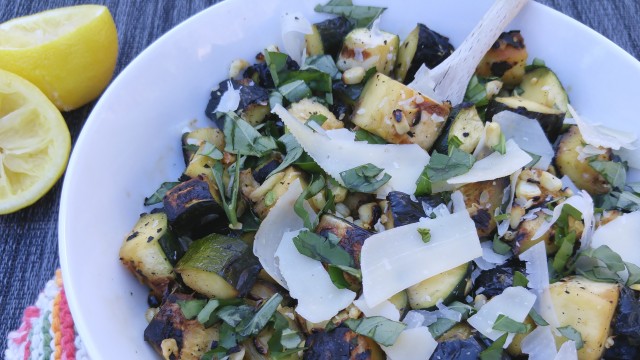
Your Portions: Reality Check Time
The most common mistake we make when trying to eat healthfully isn’t WHAT we eat, it’s how much. Portion sizes are everything, and it’s important to learn to”eyeball” your food to gauge what’s too much and what’s just right. Since each category in the formula calls for a different portion size, let’s go one by one.
Veggies
The veggie category is the easiest. Eat loads of those, since you’re probably not having enough anyways. The general rule is half your plate should be jam-packed with low-carb veggies, though personally I tend to do even more than half. Do be careful differentiating starchy veggies, like peas and corn, from the low-carb kinds. Yes, they’re “veggies”, but start affiliating them with the carb category, next to rice and pasta…and eat them in moderation as you would other carbs.
Lean Protein
The recommended portion of poultry, beef, fish, and soy products is 3-4 ounces, about the size of a deck of playing cards or similar to the size of your palm. I try to make sure James and I eat fish twice a week per the US dietary guidelines. Fish is an absolute “total package” of nutrients, so unless you’re vegetarian, make sure fish finds its way on your RV menus, too.
High-Fiber Carbs
Here’s a category where’s it’s pretty common to blow it. Overeating them is so easy, it’s one of the reasons carbs get such a bad (and unfair) rap. A healthy portion size for carbs, like rice and pasta, is around ½ cup prepared, or similar to the size of a tennis ball. I know! That seems super small, doesn’t it? Especially when you think about how huge a portion is at your favorite Italian restaurant which is WAYYY more than a tennis ball. But yep, if you want to eat healthy, ½ cup is all you get. And if we’re talking about whole-grain bread, well, you get one slice, that’s all folks. It’s okay, go load up on a veggie salad instead.
Healthy Fats
This category is going to have some variation, depending on cooking methods and what other healthy fats (like fish for example) are also being served. The serving size for an avocado can be up to 1/3 of a medium avocado, but when it’s paired with a whole meal, you’ll likely need less than that. For the other healthy fats on my example list, a serving is up to 2 tablespoons or so.
Jazz
Well this here’s the heart and soul of the meal…it’s where you can go wild, get creative, and work your culinary magic. If you’re using a store-bought sauce, my best recommendation is to read the label to figure out an appropriate portion size. I also recommend making sure you’re buying more healthed-up jazz items, so read your labels. Refined sugar isn’t your friend. Here are links to jazz I use occasionally and are Fit RV-approved:
Buffalo Sauce by Steve’s PaleoGoods
Peach BBQ Sauce by Steve’s PaleoGoods
Organic Pasta Sauce by Organico Bello
Tony Chacheres Creole Seasoning
Simply Organice Taco Seasoning
Spiceologist Smoky Honey Habanero Rub
So there you have it! A simpler stress-free way to tackle your dinners and lunches, both on and off the road. Although don’t think I’m suggesting you write off recipe-cooking completely, not at all! In fact, once planning meals as a formula becomes your “norm,” using recipes every so often actually gets more fun! It becomes more “special” that way since we’re not chained to preparing complicated meals all the time.
As always, love to hear from you! Feel free to leave comments below!
Health and Happiness,
Stef




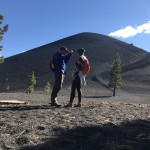
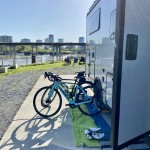





Stefany, I notice that only parmesan and goat cheese are on the list – is that because other cheeses are higher in fat? Also, what about coconut milk? I’m thinking of making coconut milk yogurt. I thought yogurt and berries would be a nice dessert!
P.S. I’m surprised that potatoes made the list. I didn’t think they were very high in fiber…
The list is just a bunch of examples so readers get an understanding of the system. It certainly isn’t the only choices you have per category, nor did I expect it to be taken as the best examples for each category. You’re meant to choose your own foods that should go in the categories using items that work for you! Hope this makes sense! 🙂
Great article Stefany! Just curious, what do you guys eat for breakfast? Do you eat breakfast?
Hi Jim! We’re all over the place on breakfasts. There’s a bunch of recipes you’ll find here on the website for breakfasts: mug omelets, homemade granola, overnight muesli, etc and those are some of our faves. I’ll also do occasional “intermittent fasting” where I skip breakfast or push it back so that I go 14 hours from the last thing I ate the night before without eating.
Hi Stefany,
Great article. We are going out for two weeks in out Trailer. Looking forward ton trying these ideas. Also, Museli. Love this stuff and been trying to figure out how to make my own.
I’ve noticed that on long trips we encountered Walmart’s way more often than Whole Foods when travelling in less populated rural areas. Perhaps some time in the future you could post “Stef’s Healthy Walmart Supercenter Food Challenge”
Something we like to bring is a 1 liter bottle of Costco’s Kirkland Signature Olive oil from Italy, Spain, or Greece. Our current favorites are the Italian Toscano and Terra Di Bari Bitonto used for dressing salads, veggies, and other stuff along with a small bottle of Trader Joe’s Balsamic Vinegar of Modena.
Olive oil and balsamic vinegar…yummo! James teases me I love them so much I’d put them on cereal!!!
This Meme is for James boondocking out in the middle of nowhere:
https://en.dopl3r.com/memes/dank/when-all-you-bought-was-healthy-food-when-you-were-motivated-but-now-youre-craving-junk-food-and-the-only-thing-available-is-kale/112040
It makes me think of the one dessert I occasionally make James…carrot souffle. He likes it well enough but always asks why he can’t have “normal” desserts…HA!
Stefany, this article is fantastic! Thanks for all the insight and analogy!
You’re most welcome, Paul! Glad you liked it. Here’s to loooong and healthy RV adventures! xoxo
Fabulous article! Although I’m a pretty serious cook, I often have limited interest in cooking once I’m on the road. Thus, I do a bunch of cooking and/or prep at home before a trip. I can’t wait to try your formula + your lunch & dinner visual as planning and packing tools on our next trip. Thank you!
I totally know what you mean, Kelli, I do that pre-prep stuff too! Sometimes that means just chopping up stuff, making sure it’s all thoroughly washed, things like that. Even though we’re talking no-recipes here in this article, I do usually freeze a soup when we’re taking off on long cool weather RV trips. Check out one of my faves, Curry Cauliflour Bisque…YUMMO! https://www.thefitrv.com/recipes/healthy-rv-eating-curried-cauliflower-bisque/
I am also into healthy lifestyles as I am 74 years old and do not take any drugs! Lucky me, but I do work on it and seem to follow your food preferences. I love cabbage for rv life as it holds up quite well.
Woot Joan….that’s AWESOME, you’re 74 and rocking it! But like you said, you work at it. There’s no other shortcut besides putting the work in if you want to be strong and healthy and youthful in the retirement years; so keep it up and never stop! xoxo
Natto? Seriously? Snot with beans? Ick!
I’ll make a note to never bring natto to an RV potluck when you’re there, Dan…ha! But seriously, don’t write it off just yet! For everyone else, natto is a Japanese style of beans with a distinctive, powerful smell (kind of like strong cheese?)… where a bacteria is added to ferment them, making them easier to digest and absorb. It’s an acquired taste, people tend to either love or hate them, and we know where Dan stands on that! But the high amounts of nutrients packed into natto are just phenomenal! Just a half cup has over 15g protein, and about 20% of your daily recommended calcium, and sooo many other vitamins and minerals! Natto contains 100 times more vitamin K2 than cheese! Plus they’re probiotic packed, and you’ll find them commonly called a “superfood”. But I will admit, they’re not too appealing to look at, lol. I prefer them when they’re wrapped in seaweed!